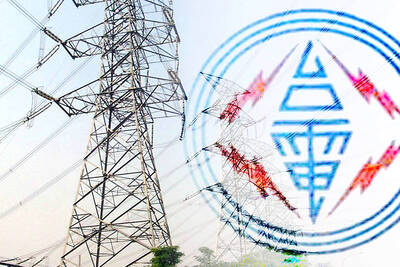The Taipei Dance Circle (光環舞集), one of Taiwan’s more unusual modern dance companies, is celebrating its 25th year, a notable milestone in any field.
To mark the anniversary of the company he founded with his wife, Maura Yang (楊宛蓉), artistic director Liou Shaw-lu (劉紹爐) decided to put away his signature baby oil to return to another of the main themes of his work in recent years, “sight and sound.”
Liou created the first program in this series, which examines the partnership between voice and movement, Sight and Sound — Exercise One, in 2001. This year’s Silent Dance is the sixth in the series. As with all the works in this series, Liou has his dancers explore the sounds they emit, including breathing, as they move, while focusing on their own body rhythms.
Liou’s choreography has long focused around the dancers’ qi, the body’s inner energy, as well as their breathing. He believes dancers must first learn to harness their qi before they can free their minds to move their bodies fluidly.
The nine-part Silent Dance, which opened yesterday at the Experimental Theater of the National Theater, is a journey for dancers and the audience, an exploration of the world around us and the world within, centered on Liou’s reflection of the ecological threat facing mankind. Liou began exploring this theme with last year’s Pilgrims’ Dream, but the flooding and mudslides brought by Typhoon Morakot gave new impetus for his concern.
As with Pilgrims’ Dream, the score for Silent Dance is a mix of genres. Last year it was the sounds of wind and waves combined with contemporary Indian music and the chanting of Buddhist monks. This year Liou turned to three composers, Lu Yen (盧炎), Tseng Yuh-chung (曾毓忠) and Lee Tzy-sheng (李子聲), to create a score that mixes Western modern classical with a soundscape of electronic “noise.”
In a rare treat for Taipei Dance Circle audiences, cellist Liu Shu-chuan (劉姝嫥) and pianist Hsieh Hsin-jung (謝新榮) will be sitting off to the left of the stage, accompanying the dancers through the series of duets, solos and quartets.
In Silent Dance, Liou said he tried to use the body to convey an absence of vulgarity, emptiness and clumsiness, and at the same time show refinement, amorousness and vivacity.
At a press preview on Wednesday afternoon, however, I found the movements of Liou and his five dancers to be somewhat stiff and clumsy looking, tentative even, but I realized that was because I am so used to seeing them gliding about the floor on slicks of baby oil. Without the lubrication, they are back to appearing as mortal as the rest of us.
Following this weekend’s performances in Taipei, the company will take Silent Dance on tour, with one performance each in Hsinchu, Tainan and Chiayi.

That US assistance was a model for Taiwan’s spectacular development success was early recognized by policymakers and analysts. In a report to the US Congress for the fiscal year 1962, former President John F. Kennedy noted Taiwan’s “rapid economic growth,” was “producing a substantial net gain in living.” Kennedy had a stake in Taiwan’s achievements and the US’ official development assistance (ODA) in general: In September 1961, his entreaty to make the 1960s a “decade of development,” and an accompanying proposal for dedicated legislation to this end, had been formalized by congressional passage of the Foreign Assistance Act. Two

March 31 to April 6 On May 13, 1950, National Taiwan University Hospital otolaryngologist Su You-peng (蘇友鵬) was summoned to the director’s office. He thought someone had complained about him practicing the violin at night, but when he entered the room, he knew something was terribly wrong. He saw several burly men who appeared to be government secret agents, and three other resident doctors: internist Hsu Chiang (許強), dermatologist Hu Pao-chen (胡寶珍) and ophthalmologist Hu Hsin-lin (胡鑫麟). They were handcuffed, herded onto two jeeps and taken to the Secrecy Bureau (保密局) for questioning. Su was still in his doctor’s robes at

Last week the Democratic Progressive Party (DPP) said that the budget cuts voted for by the China-aligned parties in the legislature, are intended to force the DPP to hike electricity rates. The public would then blame it for the rate hike. It’s fairly clear that the first part of that is correct. Slashing the budget of state-run Taiwan Power Co (Taipower, 台電) is a move intended to cause discontent with the DPP when electricity rates go up. Taipower’s debt, NT$422.9 billion (US$12.78 billion), is one of the numerous permanent crises created by the nation’s construction-industrial state and the developmentalist mentality it

Experts say that the devastating earthquake in Myanmar on Friday was likely the strongest to hit the country in decades, with disaster modeling suggesting thousands could be dead. Automatic assessments from the US Geological Survey (USGS) said the shallow 7.7-magnitude quake northwest of the central Myanmar city of Sagaing triggered a red alert for shaking-related fatalities and economic losses. “High casualties and extensive damage are probable and the disaster is likely widespread,” it said, locating the epicentre near the central Myanmar city of Mandalay, home to more than a million people. Myanmar’s ruling junta said on Saturday morning that the number killed had